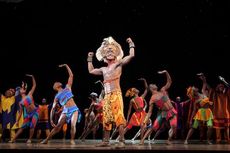
Joan Marcus / Disney Productions
Buyi Zama as "Rafiki" in the opening number "The Circle of Life" from The Lion King National Tour.

Joan Marcus / Disney Productions
Jelani Remy as "Simba" and the ensemble in "He Lives In You" from The Lion King National Tour.

Joan Marcus / Disney Productions
Syndee Winters as "Nala" and "The Lionesses" in "Shadowland."

Joan Marcus / Disney Productions
The Tree of Life from The Lion King National Tour.
Through July 8
The Peace Center: 300 South Main Street, Greenville,
Call 467-3000
Website: http://www.peacecenter.org/
Michael Carey doesn’t have to see the performance of the Lion King. He hears it.
The sound of thousands of hands clapping as the curtains rise tells him the long-awaited Broadway production is underway. The spectators’ bewilderment and amusement are heard through the oohs and aahs expressed throughout as they embrace the colors, sights and sounds.
This is, Michael Carey said, his proudest moment of the Broadway production of The Lion King.
The Lion King, the Tony Award winner for the Best Musical, debuted tonight at The Peace Center at 7:30 p.m. The musical runs through July 8. Tickets are available.
Productions are made to evoke a myriad of emotions whether it’s sadness, happiness, terror, or rage. Carey, the master carpenter for Walt Disney Productions, shares the compliments with the crew. “I often receive compliments and I respectfully pass them off to my coworkers because the greatest compliment is the response from the audience”, Carey said.
Being the designer of “Pride Rock”, the focal point throughout the musical, he plays a significant role in the presentation of The Lion King. Carey explained the wondrous centerpiece as, “similar to a remote control car.”
Pride Rock is placed on a track center stage and moves in a circular motion controlled by a wireless remote. “This piece is important to the play as many significant events, such as the presentation of Simba and the father-son speech, occur there,” Carey said.
Eighteen trailers of props from puppets to costumes are used during each performance and stored at the Peace Center ready for the next. Every storage unit is used with additional props dangling in the air behind curtains.
As technical director, Kevin Newton said, a series of inverted chain-motor systems are used to hang props suspended in mid-air above the stage. The Lion King requires about 120 chain motors opposed to the 40 used in other seasonal productions.
There’s an entirely new production behind the scene, much like walking through the wardrobe into Narnia. On either side of the stage are located lanes or alleys containing the pulley system and “fly men”, men and women who operate the chain-motors. Timing is critical. One second off and the attention of the audience is too quickly pulled to another part of the stage resulting in them missing the completion of the previous action.
Staff, actors and actresses and directors work frantically to ensure everything runs smoothly and near perfect. “Many things go wrong but the audience will never know and that is most important,” Carey said. The Peace Center is a smaller stage than Carey is used to working but is confident in the cast/team and their ability to adjust to change. Quick-change rooms are plentiful.
Julie Taymor, director and costume designer of the Broadway play, desired to create an image of the Savanna as if the audience was able to feel the heat. These acts are not easily noticed until recognition of a new costume appears. This is one example of how production can resemble sleight of hand, making the musical a magical experience.
Cast members and characters have their own rooms for more elaborate changes.
It is an amazing sight, the amount of unseen back-stage production used to create an intricate image on stage but there is also a large amount of trickery in front of the audience’s eyes. There are specific points on a stage in which it can rise or drop. At the Peace Center, however, multiple hot pink x’s mark the floor indicating points that are structurally unable to support a large amount of weight. One point in the stage in particular opens to create the effect of a watering hole. Others open allowing mist to spill onto the stage.
The Lion King was first released on film in 1994. Produced by Thomas Schumacher it was originally 74 minutes. Taking the production from screen to stage was difficult being that the first act is longer than the entire movie meaning the production had to be expanded.
Directors take advantage of the songs to enlarge the musical. Still featuring the classics by Elton John, Tim Rice, and the South African inspired tunes by Lebo M, the theatre expands on the songs, bringing them to life. Another rarity valued in the Broadway production of The Lion King would be the use of humans for animals. The leads as well as other animals are cast members wearing masks and headdresses to portray a specific species. This technique forces the audience to interact by awakening their imaginations, yet the actors embrace the animal, allowing them to strut like a lion or gallop like a gazelle in a believable fashion.
The opening scene displays a sun in the shape of a circle. Pride Rock then rises and proceeds to turn in a circular motion. The waterhole, an element crucial to life, and Mufasa’s mask are both circles. Thus, the circle of life becomes the overall thematic element of the musical. The circle is significant to balance in the world. This representation provides an added element of depth to the production. With this, The Lion King appeals to all generations, not only children. The Lion King is an example of community coming together under one shared interest.
From “Hakuna Matata” to “The Circle of Life” the Broadway production of the much-admired classic, The Lion King, brings Africa to the upstate.